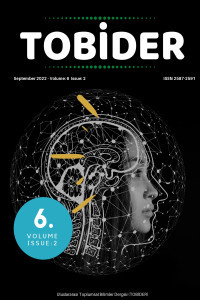İKİ YER VE ONLARIN ARASINDAKİ HAYAL ALANI- ZAHİT GÜNEY’İN “ÖZLEM-2”, “GÖÇMEN KADINLARI” VE LATİF ALİ YILDIRIM’IN “YAŞLI GÖÇMENLER” ŞİİRLERİ
Türk Göçmen Şiirleri, Vatan Olgusu, Ait Olma Olgusu, Özlem, Yer ve Ara-Alan Olgusu
PLACES AND SPACES IN ZAHIT GÜNEY’S LONGING-2 [ÖZLEM-2], THE IMMIGRANT WOMEN [GÖÇMEN KADINLARI] AND LATIF ALI YILDIRIM’S THE AGED IMMIGRANTS [YAŞLI GÖÇMENLER]
Turkish Immigration Poetry, Displacement, Home, Belonging, In-Betweenness,
___
- Azis, O. (2005). Sende Sensiz. In H. S. Yenisoy, Edebiyatımızda Balkan Türkleri'nin Göç Kaderi (p. 267). Ankara: Toplumsal Gelişim Derneği.
- Güney, Z. (2002). Özlem-2. In Z. Güney, Bölüşmek (p. 22). Istanbul: Tuna Yayınları.
- Güney, Z. (2006). Göçmen Kadınları. In Z. Güney, İnsan Yanım (pp. 68-70). Istanbul: Tuna Yayınları.
- Kahraman, C., & Güneş, İ. (2015). Tuna dergisi ve göç edebiyatına bir bakış-yazar ve şair Zahit Güney’in göç ile ilgili yazıları üzerine. In G. Şeker, A. Tilbe, & M. Ökmen, Turkish Migration Conference 2015 Selected Proceedings (pp. 527-533). London: Transnational Press London.
- McLeod, J. (2000). Diaspora Identities. In J. McLeod, Beginning Postcolonialism (pp. 205-238). Manchester: Manchester University Press.
- Sayyid, S. (2000). Beyond Westphalia: Nations and Diasporas – the Case of the Muslim Umma. In B. Hesse, Un/Settled Multiculturalisms: Diasporas, Entanglements, ‘Transruptions’ (pp. 33-50). London: Zed Books.
- Thorsell, M. D. (1998). Relevance and the translation of poetry. Revista alicantina de estudios ingleses 11, 23-32.
- Tuan, Y.-F. (2001). Space and Place: The Perspective of Experience. 1977. Minneapolis: University of Minnesota Press.
- Vlasta, S. (2015). Introduction. In S. Vlasta, Contemporary Migration Literature in German and English (pp. 1-58). Leiden I Boston: Brill I Rodopi.
- Yıldırım, L. A. (2001). Yaşlı Göçmenler. In L. A. Yıldırım, Sonbahar Çağrışımları (pp. 36-38). Istanbul: Kayhan Matbaası.
- Zafer, Z. (2012). Bulgaristan Türklerinin 89 Göçünü Hazırlayan Eritme Politikasına Karşı Direnişi. In N. Ersoy-Hacısalihoğlu, & M. Hacısalihoğlu , 89 GÖÇÜ: Bulgaristan'da 1984-89 Azınlık Politikaları ve Türkiye'ye Zorunlu Göç (pp. 199-234). Istanbul: Yıldız Teknik Unüversitesi.
- Zafer, Z., & Chernokojev, V. (2015). Kogato Mi Otneha Imeto: "Vuzroditelniyat Proces" prez 70-te - 80-te Godini na XX Vek v Literaturata na Musulmanskite Obshtnosti. Sofia: Iztok Zapad.
- Başlangıç: 2017
- Yayıncı: Sadık Hacı
Neshen GYUNANOVA ISAEVA-GYUNESH
ALMANYA’DA YÜKSELEN İSLAMOFOBİ VE DERGİLERDEKİ İSLAM KARŞITI YAYINLAR
OSMANLI’DAN GÜNÜMÜZE BULGARİSTAN’DA TÜRK KADINI
RUS EDEBİYATINDA BİR TOPOS OLARAK SİBİRYA
AYASOFYA’NIN MİMARLIK BAĞLAMINDA OKUNABİLİRLİĞİ
İZMİR MAKAM MÜZİĞİ’NE İZ BIRAKAN NURSAL ÜNSAL’IN HAYATI VE SANATÇI KİMLİĞİ
Ferhat ŞİMŞEK, Nesibe Özgül TURGAY
LİBERAL BİR PERSPEKTİFTEN SOSYAL REFAH DEVLETİ
HİNT-ĀRİ TOPLUMUNDA SU KÜLTÜ VE RİGVEDA’DA SU VE NEHİR İLAHİLERİ
